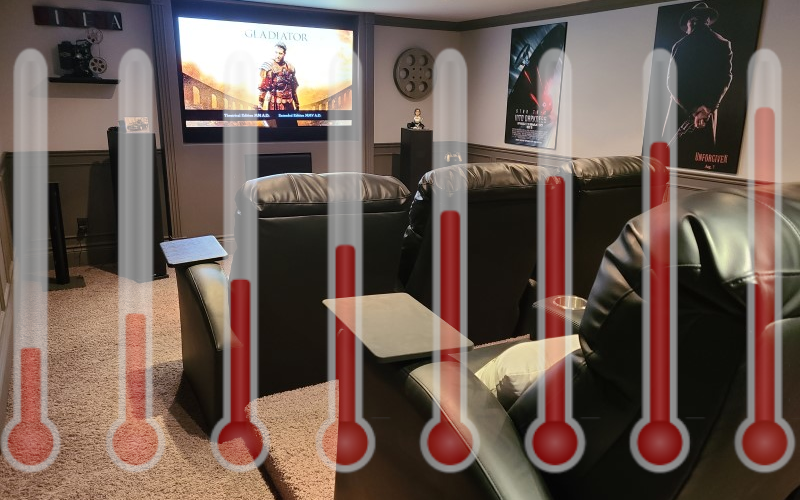Planning Your Home Theater – The Stuff You Didn’t Think About
You are the type of person that walks into a house or apartment and your first thought is, “Where would I put the home theater in here?” We get it. We are the same. You probably know all the main stuff to look for. Size of room, speaker and screen locations, where you’d put the couch, running wires…stuff like that. But there are lots of other things you should be examining in a room when planning a home theater. Here are some that most people forget.
Where Will I Place My Subs
You’ve probably considered where you will place your speakers. Maybe you’ve even measured out the angles and distances from walls. But did you consider your subwoofer locations? Subs are often bigger than we expect and can be hard to place in a room (especially if the room is smaller). When you consider a room for a home theater, you’ll need to plan for all the best places to locate your subwoofers. This means keeping in mind the locations of your speakers, seating, other furniture, lamps, and so much more. You don’t want to start setting up your home theater and then realize that your subwoofers won’t fit. Plan carefully!

In-wall Speaker Installation
It is very easy to go around a room and pick out the perfect placements for your in-wall (or in-ceiling) speakers. It seems so easy! Center your screen on your wall and then cut holes for your speakers so that they perfectly frame your screen. It’s that clean look you’ve always wanted!
It is rarely that easy.

If you aren’t walking around with at least a stud finder when planning your in-wall home theater speakers, then you are risking a lot of headaches and disappointment. The studs will determine where you can or can’t install your speakers. Plus, there are lots of other hidden problems with in-wall speakers. What’s behind the drywall (if it even is drywall)? There are lots of questions you need to answer before you can really plan for in-wall speakers. Can you get wires to the speakers? Is there enough space behind the drywall? Is there anything else behind the drywall that will make the installation difficult or impossible? If you are just looking at the walls and assuming you can install the speakers where you want, you are probably very, very wrong.
What Will Rattle
Before you plan any room for a home theater, you are going to want to walk around and see what might rattle. When your subwoofers hit and pressurize the room, things are going to start to move. You’ll need to know that before you really finalize your home theater plans. Push on the windows. Are they single-paned? Do they make any noise when you push on them? What about doors, light fixtures, or other things in the room? You should be testing everything in the room to see if it is secure. Anything that isn’t needs to either be fixed or replaced. This may affect your home theater budget.

Projector Location and Obstructions
When planning a home theater, many consider a projector a must. That’s fine. But projectors require special considerations. First and foremost, your projector must have the proper distance from the screen to get the image size you want. You must consider not only the distance from the front of the projector (the throw distance) but also the space behind the projector. When planning, don’t forget to account for any cables that will need to be connected to the back of the projector. If possible, plan for enough space so that you can be a little off without affecting performance.
Just like in-wall and in-ceiling speakers, projectors need to be concerned about what is behind the walls. Are you planning a traditional home theater projector mount? Then you’ll need to know where the studs are in the ceiling. Same is true if you are going to use something like a shelf. And don’t forget about running wires and power to the projector. If you are using a budget projector, you may need to be very precise with its placement. Is there anything hanging from the ceiling (like a fan)? You’ll either need to plan around it or pay to swap it out for something flush. Planning carefully will avoid problems later.

Temperature Control
Home theaters often get a lot hotter than the rest of your house. If you plan them right, even the interior walls have insulation (uncommon in interior walls) making your home theater more soundproof. This also keeps in the heat. Add a couple of people, some amps, and a projector and you get a room that can get (and stay) very warm. You’ll want to plan for some way to control the temperature of your home theater. If your home has an AC with zones, this may be a non-issue. If not, you may want to look into additional solutions.

Room for Treatments
We’ve seen people plan out their home theaters to the inch. They consider the number of layers of drywall, the width of their furniture, locations of acoustic panels, the angles of speakers…everything. Everything, that is, but how far off the wall their room treatments will stand. Acoustic panels need to be fairly thick to be effective. Often, it is recommended that they sit off the wall a couple of inches to increase their efficacy. This means that they may stand six inches off the wall! If you consider that at least part of the panel should be at ear level, not factoring in panel placement can make walkways too narrow, may force seating to be repositioned, and even affect speaker placement.
Take Away
There are lots of things to consider when planning a home theater. We certainly haven’t covered them all here. Do you have something you wished you had considered before assembling your home theater? Let us know in the comments!



Hi Tom,
You might have mentioned this before, but I wasn’t able to find it. If you aren’t able to have 6-inch thick absorption panels because your theater is part of another room, would having more, thinner panels have roughly the same effect?
I’m asking so I can present my ideas to the CEO of our place. Adding them in the spots needed would require them to be less conspicuous in depth.
I was hoping I could “massage the numbers” so to speak and get the desired effect.
Thanks,
Jay